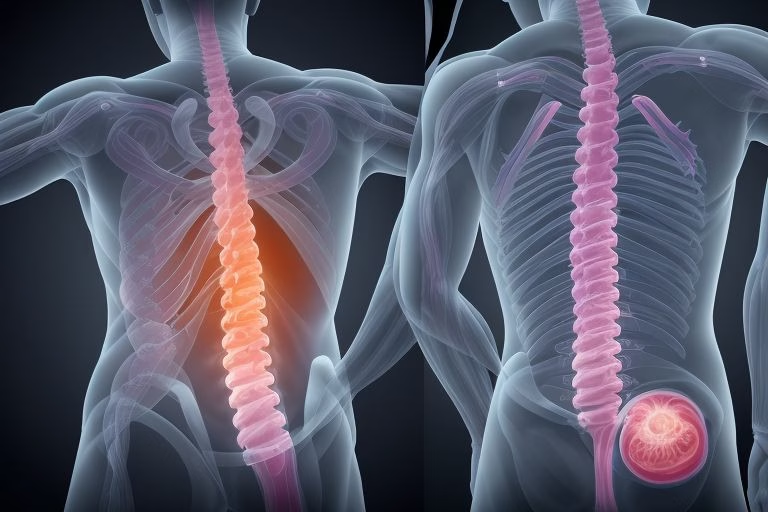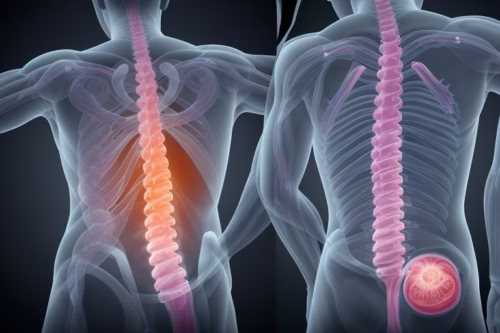
Disk degenerative disease is a condition that affects millions of people worldwide, often leading to chronic back pain, limited mobility, and reduced quality of life. In this comprehensive guide, we will explore 7 powerful strategies to overcome this challenging condition and reclaim a pain-free, active lifestyle. Whether you are newly diagnosed or have been struggling for years, this article offers actionable advice, cutting-edge treatments, and proven lifestyle changes to help you manage and even beat disk degenerative disease.
Introduction: Understanding Disk Degenerative Disease
Disk degenerative disease occurs when the intervertebral discs—the soft, cushion-like structures between the vertebrae—begin to break down. This degeneration can lead to pain, stiffness, and in severe cases, nerve compression. The journey to a healthier back starts with understanding the condition, its causes, and how modern medicine, combined with natural therapies, can offer relief.

Back pain due to disk degenerative disease is not just an inconvenience; it can drastically affect your daily activities, work, and overall well-being. With the right knowledge and a proactive approach, you can manage the symptoms, improve your quality of life, and even prevent further degeneration. Let’s dive into the essential strategies for beating disk degenerative disease.
1. Understanding the Anatomy of Your Spine
Before exploring treatment options, it is crucial to understand the basic anatomy of your spine. Your spine is composed of 33 vertebrae, each separated by intervertebral discs that act as shock absorbers. These discs consist of a tough outer layer called the annulus fibrosus and a gel-like center known as the nucleus pulposus.
As you age, the discs lose moisture and elasticity—a process that can accelerate due to injuries or genetic factors. This degeneration is at the heart of disk degenerative disease. Recognizing how your spine functions and how disk degeneration occurs empowers you to make informed decisions about your treatment options.
For a more in-depth anatomical explanation, consider visiting the Mayo Clinic’s guide on disc degeneration.
2. Causes and Risk Factors
Understanding the causes and risk factors is essential in managing disk degenerative disease. While aging is the primary factor, several other elements can accelerate the process:
- Genetics: A family history of spinal issues can predispose you to disk degenerative disease.
- Lifestyle Choices: Sedentary habits, poor posture, and smoking contribute to decreased blood flow and faster disc degeneration.
- Injury and Trauma: Repeated strain, heavy lifting, or a significant injury can damage the discs, speeding up the degeneration process.
- Obesity: Excess weight increases the load on your spine, exacerbating disc wear and tear.
- Occupational Hazards: Jobs that require heavy lifting or long periods of sitting can increase the risk.
Awareness of these factors is the first step towards prevention and management. Implementing lifestyle modifications can significantly reduce the progression of disk degenerative disease.
For additional insights on risk factors, check out this detailed article from the Cleveland Clinic.
3. Recognizing the Symptoms
The symptoms of disk degenerative disease vary from person to person but often include:
- Chronic back pain that worsens with activity or prolonged sitting.
- Stiffness in the back, especially after periods of inactivity.
- Numbness or tingling in the arms or legs if nerve roots are compressed.
- Limited mobility or difficulty bending and twisting.
- In some cases, muscle weakness.
Early recognition of these symptoms can lead to timely treatment and prevent further damage. It is essential to consult a healthcare professional if you experience persistent pain or neurological symptoms.
Learn more about common symptoms and diagnosis by visiting WebMD’s overview on degenerative disc disease.
4. Conventional Medical Treatments
When it comes to managing disk degenerative disease, conventional medical treatments play a critical role. Depending on the severity of your condition, your doctor might recommend:
Medications
- Pain Relievers: Over-the-counter options like ibuprofen or acetaminophen help manage pain.
- Muscle Relaxants: These can alleviate muscle spasms associated with back pain.
- Anti-inflammatory Drugs: These reduce inflammation around the affected disc.
Injections
- Epidural Steroid Injections: These injections deliver anti-inflammatory medication directly to the affected area, providing temporary relief.
Surgery
- Discectomy: Removing a portion of the damaged disc to relieve nerve pressure.
- Spinal Fusion: Permanently joining two or more vertebrae to stabilize the spine.
- Artificial Disc Replacement: Replacing the damaged disc with an artificial one to maintain mobility.
While surgery is often considered a last resort, advancements in medical technology have made these procedures safer and more effective. Always discuss with your healthcare provider to determine the best treatment plan for your specific condition.
For a more technical explanation and patient testimonials, visit the Johns Hopkins Medicine website.
5. Physical Therapy and Exercise: Your Key to a Healthier Spine
Physical therapy is a cornerstone in the treatment of disk degenerative disease. A skilled physical therapist can design a personalized exercise program that not only alleviates pain but also strengthens the muscles supporting your spine.
Benefits of Physical Therapy:
- Improved Flexibility: Targeted stretching exercises can help restore range of motion.
- Strength Building: Strengthening core muscles reduces the burden on the spine.
- Pain Relief: Controlled exercises can relieve tension and reduce pain.
- Preventing Future Injuries: A structured program teaches proper posture and body mechanics.
Recommended Exercises:
- Low-Impact Aerobic Activities: Walking, swimming, or cycling help improve overall fitness without putting excessive strain on your back.
- Strength Training: Exercises like planks, bridges, and pelvic tilts are excellent for building core strength.
- Stretching and Flexibility: Yoga and Pilates can enhance flexibility and reduce muscle tension.
Before starting any exercise regimen, it is essential to consult with a healthcare professional or physical therapist to ensure the program is safe and effective for your specific condition.
For detailed exercise plans and video tutorials, explore the resources available on Spine-Health.
6. Lifestyle Adjustments: Diet, Ergonomics, and Stress Management
Adopting healthy lifestyle habits is critical in managing disk degenerative disease. Small changes in your daily routine can lead to significant improvements in your spinal health.
Healthy Diet
A balanced diet rich in anti-inflammatory foods can support spinal health. Include plenty of fruits, vegetables, lean proteins, and healthy fats in your meals. Foods high in omega-3 fatty acids, such as salmon, walnuts, and flaxseeds, are particularly beneficial for reducing inflammation.
Ergonomic Workspaces
Whether you work at a desk or perform physical labor, ensuring that your workspace is ergonomically friendly is essential. Use chairs that support the natural curve of your spine, adjust your computer monitor to eye level, and take regular breaks to move around. Proper ergonomics can reduce strain and prevent worsening of disk degenerative disease.
Stress Management
Chronic stress can exacerbate back pain by causing muscle tension and inflammation. Techniques such as meditation, deep breathing exercises, and mindfulness can significantly reduce stress levels. Regular physical activity, a good night’s sleep, and hobbies that relax your mind are all beneficial in managing stress.
For more tips on ergonomics and stress management, you may refer to this helpful article on Harvard Health Publishing.
7. Alternative Treatments: Holistic Approaches and Complementary Medicine
In addition to conventional treatments, many individuals with disk degenerative disease have found relief through alternative therapies. These holistic approaches can complement traditional medicine and offer additional benefits.
Acupuncture
Acupuncture involves the insertion of thin needles into specific points on the body. Many patients report reduced pain and improved mobility after a series of acupuncture sessions. Research indicates that acupuncture can help modulate pain signals and reduce inflammation.
Chiropractic Care
Chiropractic adjustments can improve spinal alignment and relieve pressure on the nerves. Regular chiropractic visits may alleviate pain and improve overall spine function.
Massage Therapy
Therapeutic massage can reduce muscle tension and promote blood circulation, which helps in the healing process. Many patients find that massage therapy is an excellent adjunct to their treatment plan.
Herbal Supplements and Natural Remedies
Certain supplements, such as glucosamine and chondroitin sulfate, are believed to support joint health and reduce inflammation. Always consult with a healthcare provider before starting any new supplement regimen to ensure it is safe and appropriate for your condition.
For more information on alternative therapies for disk degenerative disease, visit the National Center for Complementary and Integrative Health.
8. Preventative Measures: Daily Habits to Ward Off Disk Degenerative Disease
Prevention is always better than cure. Incorporating a few simple daily habits can go a long way in preventing or slowing the progression of disk degenerative disease:
- Maintain a Healthy Weight: Reducing excess weight decreases the load on your spine and minimizes stress on the intervertebral discs.
- Stay Active: Regular exercise keeps your muscles strong and flexible. Even low-impact activities like walking or swimming can make a big difference.
- Practice Good Posture: Whether sitting or standing, maintaining proper posture can reduce undue stress on your spine.
- Use Lifting Techniques: When lifting heavy objects, always use your legs instead of your back. Keep the object close to your body and avoid twisting motions.
- Hydrate: Adequate water intake helps maintain the elasticity of your spinal discs, supporting overall spine health.
By making these preventative measures a part of your everyday routine, you can slow down the progression of disk degenerative disease and enjoy a more active, pain-free life.
9. Real Patient Success Stories
Hearing from those who have successfully managed disk degenerative disease can be incredibly motivating. Many patients have turned their lives around by embracing a combination of conventional treatments, physical therapy, and lifestyle changes.
One patient, after years of debilitating back pain, discovered that a tailored physical therapy program coupled with chiropractic care allowed her to reduce her pain significantly. She attributes her recovery to consistent exercise, proper ergonomics at work, and a diet rich in anti-inflammatory foods. Her story is a testament to the fact that, even with a diagnosis of disk degenerative disease, there is hope for recovery.
Another success story involves a patient who incorporated alternative treatments such as acupuncture and massage therapy. He combined these with regular exercise and stress management techniques, leading to a noticeable improvement in his overall back health. These success stories reinforce the idea that a comprehensive, multi-faceted approach can yield impressive results.
For more inspiring patient stories and community support, explore online health forums such as those hosted by Healthline.
10. Frequently Asked Questions (FAQs)
What is disk degenerative disease?
Disk degenerative disease is a condition characterized by the breakdown of intervertebral discs, leading to pain, stiffness, and potential nerve compression. It is primarily associated with aging but can be influenced by lifestyle and injury.
How can I tell if I have disk degenerative disease?
Common symptoms include chronic back pain, stiffness, numbness or tingling in the limbs, and reduced mobility. A definitive diagnosis requires imaging studies such as MRI or CT scans, combined with a physical examination by a healthcare professional.
Can disk degenerative disease be cured?
While the degeneration process is often irreversible, its symptoms can be managed effectively. Treatment options focus on reducing pain, improving mobility, and preventing further degeneration. A combination of medical treatment, physical therapy, and lifestyle changes can yield significant improvements.
What are the best exercises for managing disk degenerative disease?
Low-impact aerobic exercises, core strengthening routines, and stretching are highly recommended. Exercises like walking, swimming, and yoga can improve flexibility and reduce pain. However, it’s important to work with a physical therapist to develop a personalized program.
Is surgery necessary for disk degenerative disease?
Surgery is usually considered a last resort when conservative treatments have failed to provide relief. Many patients find significant improvement with non-surgical treatments such as physical therapy, medication, and alternative therapies.
Are alternative treatments effective?
Many patients report positive outcomes with alternative treatments like acupuncture, chiropractic care, and massage therapy. These therapies can complement conventional treatments and are especially useful in managing chronic pain and inflammation.
11. Your Roadmap to a Healthier Spine
Achieving a healthier spine and reducing the impact of disk degenerative disease is a journey that involves commitment and the right combination of strategies. Here’s a quick recap of the 7 unstoppable strategies:
- Understand Your Spine Anatomy – Knowledge is power. The more you understand about your spine, the better you can manage its health.
- Identify Causes and Risk Factors – Recognize and mitigate the risks through lifestyle changes.
- Recognize the Symptoms Early – Early diagnosis leads to timely treatment and better outcomes.
- Explore Conventional Medical Treatments – Medications, injections, and surgeries can provide necessary relief.
- Engage in Physical Therapy and Exercise – A tailored exercise program is essential for strength and flexibility.
- Implement Lifestyle Adjustments – Diet, ergonomics, and stress management are key in preventing further degeneration.
- Consider Alternative Treatments – Holistic approaches can complement traditional medicine and enhance overall well-being.
12. Final Thoughts: Take Charge of Your Back Health Today
Living with disk degenerative disease does not mean you have to accept a life of pain and limitations. With modern medical advancements, comprehensive physical therapy, and mindful lifestyle adjustments, you can significantly improve your quality of life and reclaim your mobility.
Remember, every journey begins with a single step. Start by consulting with a healthcare professional to discuss your symptoms and potential treatment options. Armed with the right knowledge and a proactive mindset, you can overcome the challenges of disk degenerative disease and pave the way to a brighter, healthier future.
For further reading and support, consider visiting trusted resources such as:
- Mayo Clinic on Back Pain and Disc Degeneration
- Cleveland Clinic on Degenerative Disc Disease
- Johns Hopkins Medicine
Your back health is the cornerstone of your overall well-being. By integrating these 7 unstoppable strategies into your daily routine, you are not only treating disk degenerative disease—you are building a foundation for long-term health and vitality.
If you found this guide helpful, please share it with friends and family who might be dealing with back pain. Join online communities and subscribe to newsletters for ongoing tips and expert advice on managing and preventing disk degenerative disease. Your journey to a pain-free life starts with taking informed steps today.
By embracing a proactive approach and combining modern medical practices with holistic therapies, you can achieve a life of freedom from chronic pain. Don’t let disk degenerative disease define your life—take charge, make the changes, and look forward to a healthier, more active future.
Whether you’re seeking relief from persistent back pain or simply looking to maintain optimal spine health, the strategies outlined in this article offer a roadmap to success. Disk degenerative disease may present significant challenges, but with the right knowledge and tools, you have the power to overcome it.
Embark on your journey to a healthier back with determination, and remember that every positive change, no matter how small, contributes to your overall well-being. Stay informed, stay active, and most importantly, believe in your ability to reclaim your life.
For more expert tips and updates on managing spinal health, be sure to follow reputable medical blogs and forums. Your commitment to improving your health can inspire others, creating a community of support and empowerment for those dealing with disk degenerative disease.
Take the first step today and transform your life—your back deserves it!



